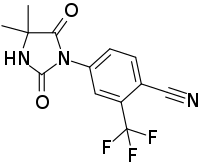Cyanonilutamide
Cyanonilutamide (developmental code name RU-56279) is a nonsteroidal antiandrogen which was never marketed.[1][2] Both RU-56187 and RU-58841 appear to be prodrugs of cyanonilutamide in vivo in animals.[2] It has relatively low affinity for the androgen receptor but nonetheless shows significant antiandrogenic activity in animals.[2]
| Compound | AR | ER | PR | GR | MR |
|---|---|---|---|---|---|
| Metribolone | 290 | < 0.1 | 190 | 4 | 38 |
| Dihydrotestosterone | 180 | ? | ? | ? | ? |
| Testosterone | 100 | ? | ? | ? | ? |
| Cyproterone acetate | 10 | ? | ? | ? | ? |
| Bicalutamide | 1.8 | ? | ? | ? | ? |
| Nilutamide | 0.8 | ? | ? | ? | ? |
| Hydroxyflutamide | 0.8 | ? | ? | ? | ? |
| RU-59063 | 300 | <0.1 | <0.1 | <0.1 | <0.1 |
| RU-58841 | 150 | ? | ? | ? | ? |
| RU-58642 | 46 | <0.1 | <0.1 | <0.1 | <0.1 |
| RU-57073 | 163 | <0.1 | <0.1 | <0.1 | <0.1 |
| RU-56187 | 92 | <0.1 | <0.1 | <0.1 | <0.1 |
| Notes: Values are RBAs (%). Reference ligands (100%) were testosterone for the AR, estradiol for the ERα and ERβ, progesterone for the PR, dexamethasone for the GR, and aldosterone for the MR. Sources: See template. | |||||
 | |
| Clinical data | |
|---|---|
| Other names | RU-56279 |
| Drug class | Nonsteroidal antiandrogen |
| Identifiers | |
IUPAC name
| |
| CAS Number | |
| PubChem CID | |
| ChemSpider | |
| ChEMBL | |
| Chemical and physical data | |
| Formula | C13H10F3N3O2 |
| Molar mass | 297.237 g·mol−1 |
| 3D model (JSmol) | |
SMILES
| |
InChI
| |
See also
References
- Gryder BE, Akbashev MJ, Rood MK, Raftery ED, Meyers WM, Dillard P, Khan S, Oyelere AK (November 2013). "Selectively targeting prostate cancer with antiandrogen equipped histone deacetylase inhibitors". ACS Chem. Biol. 8 (11): 2550–60. doi:10.1021/cb400542w. PMC 3836611. PMID 24004176.
- Cousty-Berlin D, Bergaud B, Bruyant MC, Battmann T, Branche C, Philibert D (October 1994). "Preliminary pharmacokinetics and metabolism of novel non-steroidal antiandrogens in the rat: relation of their systemic activity to the formation of a common metabolite". J. Steroid Biochem. Mol. Biol. 51 (1–2): 47–55. doi:10.1016/0960-0760(94)90114-7. PMID 7947350.
This article is issued from
Wikipedia.
The text is licensed under Creative
Commons - Attribution - Sharealike.
Additional terms may apply for the media files.